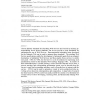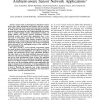116 search results - page 21 / 24 » Contract-Based Discovery and Composition of Web Services |
WWW
2007
ACM
16 years 10 days ago
2007
ACM
Current industry standards for describing Web Services are focused on ensuring interoperability across diverse platforms, but do not provide a good foundation for automating the u...
ESWS
2005
Springer
15 years 5 months ago
2005
Springer
The power of Web Service (WS) technology lies in the fact that it establishes a common, vendor-neutral platform for integrating distributed computing applications, in intranets as ...
89
Voted
OTM
2007
Springer
15 years 5 months ago
2007
Springer
The information that is made available through the semantic web will be accessed through complex programs (web-services, sensors, etc.) that may interact in sophisticated ways. Com...
105
click to vote
BROADNETS
2006
IEEE
15 years 3 months ago
2006
IEEE
Sensor webs are heterogeneous collections of sensor devices that collect information and interact with the environment. They consist of wireless sensor networks that are ensembles ...
ESWS
2007
Springer
15 years 5 months ago
2007
Springer
WSML is an ontology language specifically tailored to annotate Web Services, and part of its semantics adheres to the rule-based knowledge representation paradigm of logic program...



